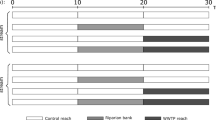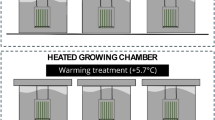Abstract
The objective of the study was to evaluate the effect of different concentrations of nitrogen and phosphorus on the growth of the free-floating aquatic macrophytes Eichhornia crassipes, Pistia stratiotes, and Salvinia molesta. The plants were cultured in 2,000-l outdoor concrete tanks. Triplicate tanks, with a continuous flow of effluent from culture ponds containing Nile tilapia, were used for each plant type (n = 3). The plant material was collected monthly from 0.25 m2 floating quadrats, at the two ends of the tanks (higher nutrient concentrations near the inflow and lower nutrient concentrations near the outflow). In low nutrient concentrations, the maximum relative growth rates (RGRs) for E. crassipes (0.016/day) and P. stratiotes (0.016/day) were significantly lower (P ≤ 0.05) than for S. molesta (0.029/day). There were no significant differences between the RGRs of S. molesta in the different nutrient concentrations. Eichhornia crassipes and P. stratiotes had their growth limited by nitrogen and phosphorus concentrations. The increase in plant density during the experiment probably also affected the growth of these species. In this context, E. crassipes and P. stratiotes can cause problems in nutrient-rich waterbodies, but under these experimental conditions their growth was limited by nitrogen and/or phosphorus concentrations. The growth of S. molesta was not influenced by the different nutrient concentrations.



Similar content being viewed by others
References
Adams, S., R. R. Boar, D. S. Hubble, M. Gikungu, D. M. Harper, P. Hickley & N. Tarras-Wahlberg, 2002. The dynamics and ecology of exotic tropical species in floating plant mats: Lake Naivasha, Kenya. Hydrobiologia 488: 115–122.
Bini, L. M., S. M. Thomaz, K. J. Murphy & A. F. M. Camargo, 1999. Aquatic macrophyte distribution in relation to water and sediment conditions in the Itaipu Reservoir, Brazil. Hydrobiologia 415: 147–154.
Brendonck, L., J. Maes, W. Rommens, N. Dekeza, T. Nhiwatiwa, M. Barson, V. Callebaut, C. Phiri, K. Moreau, B. Gratwicke, M. Stevens, N. Alyn, E. Holsters, F. Ollevier & B. Marshall, 2003. The impact of water hyacinth (Eichhornia crassipes) in a eutrophic subtropical impoundment (Lake Chivero, Zimbabwe). II. Species diversity. Archiv für Hydrobiologie 158(3): 389–405.
Caffrey, J. M., C. Monahan & D. Tierney, 2006. Factors influencing the distribution of aquatic plant communities in Irish canals. Hydrobiologia 570: 133–139.
Camargo, A. F. M., M. M. Pezzato & G. G. Henry-Silva, 2003. Fatores limitantes ao crescimento de macrófitas aquáticas. In Thomaz, S. M. & L. M. Bini (eds), Ecologia e Manejo de Macrófitas Aquáticas. Eduem, Maringá: 59–84.
Camargo, A. F. M., M. M. Pezzato, G. G. Henry-Silva & A. M. Assumpção, 2006. Primary production of Utricularia foliosa L., Egeria densa Planchon and Cabomba furcata Schult & Schult from rivers of the coastal plain of the State of São Paulo, Brazil. Hydrobiologia 570: 35–39.
Chambers, P. A., P. Lacoul, K. J. Murphy & S. M. Thomaz, 2008. Global diversity of aquatic macrophytes in freshwater. Hydrobiologia 595(1): 9–26.
Cook, C. D. K., 1990. Origin, autecology, and spread of some of the world’s most troublesome aquatic weeds. In Pieterse, A. H. & K. J. Murphy (eds), Aquatic Weeds. Oxford University Press, Oxford: 31–38.
Costa-Pierce, B. A., 1998. Preliminary investigation of an integrated aquaculture-wetland ecosystem using tertiary-treated municipal wastewater in Los Angeles County, California. Ecological Engineering 10: 341–354.
Daniel, H., I. Bernez & J. Haury, 2006. Relationships between macrophytic vegetation and physical features of river habitats: The need for a morphological approach. Hydrobiologia 570: 11–17.
Engelhardt, K. A. M. & M. E. Ritchie, 2001. Effects of macrophyte species richness on wetland ecosystem functioning and services. Nature 411: 687–689.
Finlayson, C. M., 1984. Growth rates of Salvinia molesta in Lake Moondarra, Mount Isa, Australia. Aquatic Botany 18: 257–262.
Fitzsimons, R. E. & R. H. Vallejos, 1986. Growth of water hyacinth (Eichhornia crassipes (Mart.) Solms) in the middle Paraná River (Argentina). Hydrobiologia 131(3): 257–260.
Golterman, H. L., R. S. Clymo & M. A. M. Ohsnstad, 1978. Methods for Physical and Chemical Analysis of Freshwaters. Blackwell, Boston.
Henry-Silva, G. G. & A. F. M. Camargo, 2005. Interações ecológicas entre as macrófitas aquáticas flutuantes Eichhornia crassipes e Pistia stratiotes. Hoehnea 32(3): 445–452.
Henry-Silva, G. G. & A. F. M. Camargo, 2006. Efficiency of aquatic macrophytes to treat Nile tilapia pond effluents. Scientia Agricola 63: 433–438.
Holm, L. G., D. L. Plucknett, J. V. Pancho & J. P. Herberger, 1977. The World’s Worst Weeds—Distribution and Biology. University Press, Hawaii.
Joye, D. A., B. Oertli, A. Lehmann, R. Juge & J. B. Lachavanne, 2006. The prediction of macrophyte species occurrence in Swiss ponds. Hydrobiologia 570(1): 175–182.
Junk, J. W. & M. T. F. Piedade, 1997. Plant life in the floodplain with special reference to herbaceous plants. In Junk, J. W. (ed.), The Central Amazon Floodplain: Ecology of a Pulsing System. Springer-Verlag, Berlin: 147–185.
Koroleff, F., 1976. Determination of nutrients. In Grasshoff, K. (ed.), Methods of Seawater Analysis. Verlag Chemie, Weinheim/New York: 117–181.
Lansac-Toha, F. M., L. F. M. Velho & C. C. Bonecker, 2003. Influência de macrófitas aquáticas sobre a estrutura da comunidade zooplanctônica. In Thomaz, S. M. & L. M. Bini (eds), Ecologia e Manejo de Macrófitas Aquáticas. Eduem, Maringá: 231–242.
Mackereth, F. J. H., J. G. Heron & J. F. Talling, 1978. Water analysis: Some revised methods for limnologists. Freshwater Biological Association, Scientific Publication 36.
Mansor, M., 1996. Noxious floating weeds of Malaysia. Hydrobiologia 340: 121–125.
Mbati, G. & P. Neuenschwander, 2005. Biological control of three floating water weeds, Eichhornia crassipes, Pistia stratiotes, and Salvinia molesta in the Republic of Congo. BioControl 50(4): 635–645.
Milne, J. M., K. J. Murphy & S. M. Thomaz, 2006. Morphological variation in Eichhornia azurea (Kunth) and Eichhornia crassipes (Mart.) Solms in relation to aquatic vegetation type and the environment in the floodplain of the Rio Paraná, Brazil. Hydrobiologia 570: 19–25.
Mitchell, D. S. & N. M. Tur, 1975. The rate of growth of Salvinia molesta (S. auriculata Auct) in laboratory and natural conditions. Journal of Applied Ecology 12: 213–225.
Pelicice, F. M., A. A. Agostinho & S. M. Thomaz, 2005. Fish assemblages associated with Egeria in a tropical reservoir: Investigating the effects of plant biomass and diel period. Acta Oecologica 27: 9–16.
Pieterse, A. H. & K. J. Murphy, 1990. Aquatic Weeds. Oxford University Press, Oxford.
Ran, N., M. Agami & G. Oron, 2004. A pilot study of constructed wetlands using duckweed (Lemna gibba L.) for treatment of domestic primary effluent in Israel. Water Research 38: 2241–2248.
Redding, T., S. Todd & A. Midlen, 1997. The treatment of aquaculture wastewater—A botanical approach. Journal of Environmental Management 50: 283–299.
Reddy, K. R. & W. F. DeBusk, 1984. Growth characteristics of aquatic macrophytes cultured in nutrient-enriched water. I water hyacinth, water lettuce, and pennywort. Economic Botany 38(2): 229–239.
Rubim, M. A. L. & A. F. M. Camargo, 2001. Taxa de crescimento específico da macrófita aquática Salvinia molesta Mitchell em um braço do Rio Preto, Itanhaém, São Paulo. Acta Limnologica Brasiliensia 13(1): 75–83.
Sale, P. J. M., P. T. Orr, G. S. Shell & D. J. C. Erskine, 1985. Photosyntesis and growth rates in Salvinia molesta and Eichhornia crassipes. Journal of Applied Ecology 22: 125–137.
Sand-Jensen, K., 1989. Environmental variables and their effect on photosynthesis of aquatic plant communities. Aquatic Botany 34: 5–25.
Sharma, B. M. & M. K. C. Sridhar, 1989. Growth characteristics of water lettuce (Pistia stratiotes L.) in South-West Nigeria. Archiv für Hydrobiologie 115(2): 305–312.
Taheruzzaman, Q. & D. P. Kushari, 1988. Production rate of Eichhornia crassipes (Mart.) Solms in river Ganga water. Hydrobiologia 22(2): 163–171.
Thomaz, S. M. & L. M. Bini, 1998. Ecologia e manejo de macrófitas aquáticas em reservatórios. Acta Limnologica Brasiliensia 10: 103–116.
Thomaz, S. M., T. A. Paggioro, L. M. Bini & K. J. Murphy, 2006. Effects of reservoir drawdown on biomass of three species of aquatic macrophytes in a large sub-tropical reservoir (Itaipu, Brazil). Hydrobiologia 570: 53–59.
Usha Rani, V. U. & S. Bhambie, 1983. A study on the growth of Salvinia molesta Mitchell in relation to light and temperature. Aquatic Botany 17: 119–124.
Van Den Berg, M. S., H. Coops, R. Noordhuis, J. Van Schie & J. Simons, 1997. Macroinvertebrate communities in relation to submerged vegetation in two Chara-dominated lakes. Hydrobiologia 342/343: 143–150.
Vereecken, H., J. Baetens, P. Viaene, F. Mostaert & P. Meire, 2006. Ecological management of aquatic plants: Effects in lowland streams. Hydrobiologia 570(1): 205–210.
Acknowledgments
The authors acknowledge Sidinei M. Thomaz and two anonymous reviewers for constructive and helpful comments. We also thank Osmar Cantelmo (CEPTA/IBAMA) and Carlos Sanches for fieldwork and laboratory analyses, Miguel Petrere Jr. and Janet W. Reid for correcting the English text, and Rodrigo Silva Costa for critical comments. Financial support: FAPESP. Process number: 98/16375-1.
Author information
Authors and Affiliations
Corresponding author
Additional information
Handling editor: S. M. Thomaz
Rights and permissions
About this article
Cite this article
Henry-Silva, G.G., Camargo, A.F.M. & Pezzato, M.M. Growth of free-floating aquatic macrophytes in different concentrations of nutrients. Hydrobiologia 610, 153–160 (2008). https://doi.org/10.1007/s10750-008-9430-0
Received:
Revised:
Accepted:
Published:
Issue Date:
DOI: https://doi.org/10.1007/s10750-008-9430-0




